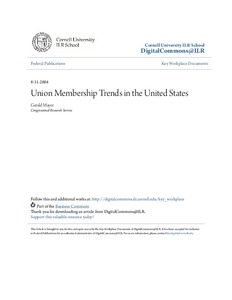Union membership trends in the United States
"Union membership in the United States has declined significantly in recent decades. The number of union members peaked in 1979 at an estimated 21.0 million. In 2003, an estimated 15.8 million workers were union members. As a percent of employed workers, union membership peaked in 1954 at 28.3%...
| Main Author: | |
|---|---|
| Institution: | ETUI-European Trade Union Institute |
| Format: | TEXT |
| Language: | English |
| Published: |
Washington
2004
Congressional Research Service |
| Subjects: | |
| Online Access: | https://www.labourline.org/KENTIKA-19392893124911100759-union-membership-trends-in-the.htm |
| Summary: | "Union membership in the United States has declined significantly in recent decades. The number of union members peaked in 1979 at an estimated 21.0 million. In 2003, an estimated 15.8 million workers were union members. As a percent of employed workers, union membership peaked in 1954 at 28.3%. In 2003, 11.5% of employed workers were union members. Most studies find that, after controlling for individual, job, and labor market characteristics, the wages of union workers are in the range of 10% to 30% higher than the wages of nonunion workers. The wage premium is generally greater for less skilled, less-educated, and younger workers and larger for private than public sector workers. Union members generally receive better or more generous fringe benefits than similar nonunion workers. Job tenure tends to be greater and quit rates lower among unionized workers. However, the wage premium may have declined in recent years. ..." |
|---|---|
| Physical Description: | 42 p. Digital |

